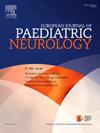疾病修饰疗法时代脊髓性肌萎缩症的基因型-表型相关性:第三代印度经验
IF 2.3
3区 医学
Q3 CLINICAL NEUROLOGY
引用次数: 0
摘要
目的将SMN2 CN与印度所有SMA类型的发病年龄、严重程度、运动能力和合并症相关联。方法:这项回顾性研究收集和分析了200名遗传确诊的SMA患者的临床数据、运动评估评分和SMN遗传学,这些患者在两年内转介到我们的儿科神经肌肉中心。结果200例患者中,SMA1 49例,SMA2 82例,SMA3 64例,SMA4 5例。大多数患者为男性(59%),大多数来自印度南部的五个邦。值得注意的是,23%的患者表现出父母的血缘关系。我们的分析显示,SMN2拷贝数与疾病发病以及发育里程碑的实现之间存在很强的相关性。这一趋势与正式的运动评估评分以及合并症的存在和严重程度一致,强调了SMN2作为疾病调节剂的关键作用。此外,我们观察到一小部分临床SMA类型不同但SMN2 CN相同的患者。这项研究强调了SMN2作为SMA疾病调节剂的关键作用,它与疾病表型、运动评分和合并症的发生有很强的相关性。研究结果强调了密切监测和遵守护理标准(SOC)协议的重要性,这有助于主动管理并发症和合并症。这些做法有助于改善生活质量和更好的结果为SMA患者在新的治疗方法的时代。本文章由计算机程序翻译,如有差异,请以英文原文为准。
Genotype – phenotype correlation of Spinal Muscular Atrophy in the era of disease modifying therapies: A tertiary Indian experience
Aim
To correlate SMN2 CN with age of disease onset, severity, motor ability and comorbidities across all SMA types from India.
Methods
This retrospective study involved the collection and analysis of clinical data, motor assessment scores, and SMN genetics from a cohort of 200 genetically confirmed SMA patients who were referred to our Paediatric Neuromuscular Centre over two years.
Results
Among the 200 subjects, 49 had SMA1, 82 had SMA2, 64 had SMA3, and 5 had SMA4. The majority of patients were male (59 %), and most hailed from the five Southern Indian states. Notably, 23 % of patients exhibited parental consanguinity. Our analysis revealed a strong correlation between the number of SMN2 copies and disease onset, as well as the achievement of developmental milestones. This trend was consistent with formal motor assessment scores and the presence and severity of co-morbidities, underscoring the pivotal role of SMN2 as a disease modifier. Additionally, we observed a small subset of patients with clinically diverse SMA types but identical SMN2 CN.
Interpretation
This study emphasizes the critical role of SMN2 as a disease modifier in SMA, as evidenced by its strong correlation with disease phenotype, motor scores, and the occurrence of co-morbidities. The findings underscore the importance of close monitoring and adherence to standard of care (SOC) protocols, which facilitate the proactive management of complications and co-morbidities. These practices contribute to an improved quality of life and better outcomes for SMA patients in the era of novel therapeutic approaches.
求助全文
通过发布文献求助,成功后即可免费获取论文全文。
去求助
来源期刊
CiteScore
6.30
自引率
3.20%
发文量
115
审稿时长
81 days
期刊介绍:
The European Journal of Paediatric Neurology is the Official Journal of the European Paediatric Neurology Society, successor to the long-established European Federation of Child Neurology Societies.
Under the guidance of a prestigious International editorial board, this multi-disciplinary journal publishes exciting clinical and experimental research in this rapidly expanding field. High quality papers written by leading experts encompass all the major diseases including epilepsy, movement disorders, neuromuscular disorders, neurodegenerative disorders and intellectual disability.
Other exciting highlights include articles on brain imaging and neonatal neurology, and the publication of regularly updated tables relating to the main groups of disorders.

 求助内容:
求助内容: 应助结果提醒方式:
应助结果提醒方式:


